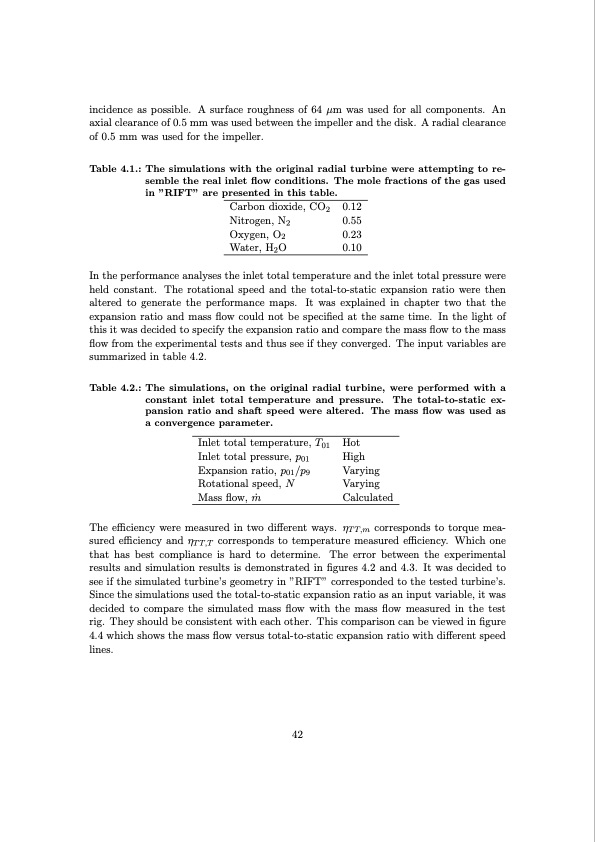
PDF Publication Title:
Text from PDF Page: 049
incidence as possible. A surface roughness of 64 μm was used for all components. An axial clearance of 0.5 mm was used between the impeller and the disk. A radial clearance of 0.5 mm was used for the impeller. Table 4.1.: The simulations with the original radial turbine were attempting to re- semble the real inlet flow conditions. The mole fractions of the gas used in ”RIFT” are presented in this table. Carbon dioxide, CO2 0.12 Nitrogen, N2 0.55 Oxygen, O2 0.23 Water, H2O 0.10 In the performance analyses the inlet total temperature and the inlet total pressure were held constant. The rotational speed and the total-to-static expansion ratio were then altered to generate the performance maps. It was explained in chapter two that the expansion ratio and mass flow could not be specified at the same time. In the light of this it was decided to specify the expansion ratio and compare the mass flow to the mass flow from the experimental tests and thus see if they converged. The input variables are summarized in table 4.2. Table 4.2.: The simulations, on the original radial turbine, were performed with a constant inlet total temperature and pressure. The total-to-static ex- pansion ratio and shaft speed were altered. The mass flow was used as a convergence parameter. Inlet total temperature, T01 Inlet total pressure, p01 Expansion ratio, p01 /p9 Rotational speed, N Mass flow, m ̇ Hot High Varying Varying Calculated The efficiency were measured in two different ways. ηTT,m corresponds to torque mea- sured efficiency and ηTT,T corresponds to temperature measured efficiency. Which one that has best compliance is hard to determine. The error between the experimental results and simulation results is demonstrated in figures 4.2 and 4.3. It was decided to see if the simulated turbine’s geometry in ”RIFT” corresponded to the tested turbine’s. Since the simulations used the total-to-static expansion ratio as an input variable, it was decided to compare the simulated mass flow with the mass flow measured in the test rig. They should be consistent with each other. This comparison can be viewed in figure 4.4 which shows the mass flow versus total-to-static expansion ratio with different speed lines. 42PDF Image | A Detailed Analysis of Radial Turbines

PDF Search Title:
A Detailed Analysis of Radial TurbinesOriginal File Name Searched:
exjobb_final_official_version_Erik_Svensson.pdfDIY PDF Search: Google It | Yahoo | Bing
NFT (Non Fungible Token): Buy our tech, design, development or system NFT and become part of our tech NFT network... More Info
IT XR Project Redstone NFT Available for Sale: NFT for high tech turbine design with one part 3D printed counter-rotating energy turbine. Be part of the future with this NFT. Can be bought and sold but only one design NFT exists. Royalties go to the developer (Infinity) to keep enhancing design and applications... More Info
Infinity Turbine IT XR Project Redstone Design: NFT for sale... NFT for high tech turbine design with one part 3D printed counter-rotating energy turbine. Includes all rights to this turbine design, including license for Fluid Handling Block I and II for the turbine assembly and housing. The NFT includes the blueprints (cad/cam), revenue streams, and all future development of the IT XR Project Redstone... More Info
Infinity Turbine ROT Radial Outflow Turbine 24 Design and Worldwide Rights: NFT for sale... NFT for the ROT 24 energy turbine. Be part of the future with this NFT. This design can be bought and sold but only one design NFT exists. You may manufacture the unit, or get the revenues from its sale from Infinity Turbine. Royalties go to the developer (Infinity) to keep enhancing design and applications... More Info
Infinity Supercritical CO2 10 Liter Extractor Design and Worldwide Rights: The Infinity Supercritical 10L CO2 extractor is for botanical oil extraction, which is rich in terpenes and can produce shelf ready full spectrum oil. With over 5 years of development, this industry leader mature extractor machine has been sold since 2015 and is part of many profitable businesses. The process can also be used for electrowinning, e-waste recycling, and lithium battery recycling, gold mining electronic wastes, precious metals. CO2 can also be used in a reverse fuel cell with nafion to make a gas-to-liquids fuel, such as methanol, ethanol and butanol or ethylene. Supercritical CO2 has also been used for treating nafion to make it more effective catalyst. This NFT is for the purchase of worldwide rights which includes the design. More Info
NFT (Non Fungible Token): Buy our tech, design, development or system NFT and become part of our tech NFT network... More Info
Infinity Turbine Products: Special for this month, any plans are $10,000 for complete Cad/Cam blueprints. License is for one build. Try before you buy a production license. May pay by Bitcoin or other Crypto. Products Page... More Info
| CONTACT TEL: 608-238-6001 Email: greg@infinityturbine.com | RSS | AMP |